Scale Effects of Water Saving on Irrigation Efficiency: Case Study of a Rice-Based Groundwater Irrigation System on the Sanjiang Plain, Northeast China
Abstract
:1. Introduction
2. Materials and Methods
2.1. Study Area and Data
2.2. Distributed Water Balance Model
2.3. Water Use Efficiency at Multiple Levels
2.4. Arrangements of Modeling Scenarios
3. Results and Discussion
3.1. Water Balance Model Calibration and Validation
3.2. Current Irrigation Efficiency Across Different Scales
3.3. Scale Effects of Simulated Water-Saving Measures on Irrigation Efficiency
4. Conclusions
Acknowledgments
Author Contributions
Conflicts of Interest
References
- Seekell, D.; Carr, J.; Dell’Angelo, J.; D’Odorico, P.; Fader, M.; Gephart, J.; Kummu, M.; Magliocca, N.; Porkka, M.; Puma, M.; et al. Resilience in the global food system. Environ. Res. Lett. 2017. [Google Scholar] [CrossRef]
- Jägermeyr, J.; Gerten, D.; Schaphoff, S.; Heinke, J.; Lucht, W.; Rockström, J. Integrated crop water management might sustainably halve the global food gap. Environ. Res. Lett. 2016, 11, 025002. [Google Scholar] [CrossRef]
- Ashofteh, P.-S.; Bozorg-Haddad, O.; Loáiciga, H.A. Development of adaptive strategies for irrigation water demand management under climate change. J. Irrig. Drain. Eng. 2017, 143, 04016077. [Google Scholar] [CrossRef]
- Sun, H.; Wang, S.; Hao, X. An improved analytic hierarchy process method for the evaluation of agricultural water management in irrigation districts of north china. Agric. Water Manag. 2017, 179, 324–337. [Google Scholar] [CrossRef]
- Pereira, H.; Marques, R.C. An analytical review of irrigation efficiency measured using deterministic and stochastic models. Agric. Water Manag. 2017, 184, 28–35. [Google Scholar] [CrossRef]
- Yan, Z.; Gao, C.; Ren, Y.; Zong, R.; Ma, Y.; Li, Q. Effects of pre-sowing irrigation and straw mulching on the grain yield and water use efficiency of summer maize in the north china plain. Agric. Water Manag. 2017, 186, 21–28. [Google Scholar] [CrossRef]
- Wang, Y.B.; Liu, D.; Cao, X.C.; Yang, Z.Y.; Song, J.F.; Chen, D.Y.; Sun, S.K. Agricultural water rights trading and virtual water export compensation coupling model: A case study of an irrigation district in china. Agric. Water Manag. 2017, 180, 99–106. [Google Scholar] [CrossRef]
- Zhang, H.; Xiong, Y.; Huang, G.; Xu, X.; Huang, Q. Effects of water stress on processing tomatoes yield, quality and water use efficiency with plastic mulched drip irrigation in sandy soil of the hetao irrigation district. Agric. Water Manag. 2017, 179, 205–214. [Google Scholar] [CrossRef]
- Howell, T.A. Irrigation efficiency. In Encyclopedia of Water Science; Marcel Dekker: New York, NY, USA, 2003; pp. 467–472. [Google Scholar]
- Giuliani, M.M.; Gatta, G.; Nardella, E.; Tarantino, E. Water saving strategies assessment on processing tomato cultivated in mediterranean region. Ital. J. Agron. 2016, 11, 69–76. [Google Scholar] [CrossRef]
- Burt, C.M.; Clemmens, A.J.; Strelkoff, T.S.; Solomon, K.H.; Bliesner, R.D.; Hardy, L.A.; Howell, T.A.; Eisenhauer, D.E. Irrigation performance measures: Efficiency and uniformity. J. Irrig. Drain. Eng. 1997, 123, 423–442. [Google Scholar] [CrossRef]
- Bouman, B.A.M. A conceptual framework for the improvement of crop water productivity at different spatial scales. Agric. Syst. 2007, 93, 43–60. [Google Scholar] [CrossRef]
- Hafeez, M.M.; Bouman, B.A.M.; Van de Giesen, N.; Vlek, P. Scale effects on water use and water productivity in a rice-based irrigation system (upriis) in the Philippines. Agric. Water Manag. 2007, 92, 81–89. [Google Scholar] [CrossRef]
- Bouman, B. Water Management in Irrigated Rice: Coping with Water Scarcity; International Rice Research Institute: Los Baños, Philippines, 2007. [Google Scholar]
- Expósito, A.; Berbel, J. Agricultural irrigation water use in a closed basin and the impacts on water productivity: The case of the guadalquivir river basin (southern Spain). Water 2017, 9, 136. [Google Scholar] [CrossRef]
- Bouman, B.A.M.; Tuong, T.P. Field water management to save water and increase its productivity in irrigated lowland rice. Agric. Water Manag. 2001, 49, 11–30. [Google Scholar] [CrossRef]
- Droogers, P.; Kite, G. Water productivity from integrated basin modeling. Irrig. Drain. Syst. 1999, 13, 275–290. [Google Scholar] [CrossRef]
- Molle, F.; Venot, J.-P.; Lannerstad, M.; Hoogesteger, J. Villains or heroes? Farmers’ adjustments to water scarcity. Irrig. Drain. 2010, 59, 419–431. [Google Scholar] [CrossRef]
- Expósito, A.; Berbel, J. Sustainability implications of deficit irrigation in a mature water economy: A case study in southern Spain. Sustainability 2017, 9, 1144. [Google Scholar] [CrossRef]
- Playán, E.; Mateos, L. Modernization and optimization of irrigation systems to increase water productivity. Agric. Water Manag. 2006, 80, 100–116. [Google Scholar] [CrossRef] [Green Version]
- Bahri, A. Agricultural reuse of wastewater and global water management. Water Sci. Technol. 1999, 40, 339–346. [Google Scholar]
- Simons, G.W.H.; Bastiaanssen, W.G.M.; Immerzeel, W.W. Water reuse in river basins with multiple users: A literature review. J. Hydrol. 2015, 522, 558–571. [Google Scholar] [CrossRef]
- Bos, M.; Wolters, W. Project or overall irrigation efficiency. In Proceedings of the International Conference in Irrigation Theory and Practice, Southampton, UK, 12–15 September 1989; Rydzewski, J.R., Ward, C.F., Eds.; Pentech Press: London, UK, 1989; pp. 499–506. [Google Scholar]
- Tuong, T.P.; Bouman, B.A.M.; Mortimer, M. More rice, less water—Integrated approaches for increasing water productivity in irrigated rice-based systems in Asia. Plant Prod. Sci. 2005, 8, 231–241. [Google Scholar] [CrossRef]
- Bouman, B.A.M.; Humphreys, E.; Tuong, T.P.; Barker, R. Rice and water. In Advances in Agronomy; Sparks, D.L., Ed.; Academic Press: Cambridge, MA, USA, 2007; Volume 92, pp. 187–237. [Google Scholar]
- Willardson, L.S. Basin-wide impacts of irrigation efficiency. J. Irrig. Drain. Eng. 1985, 111, 241–246. [Google Scholar] [CrossRef]
- Molden, D. Accounting for Water Use and Productivity; International Water Management Institute: Colombo, Sri Lanka, 1997. [Google Scholar]
- Palanisami, K.; Senthilvel, S.; Ramesh, T. Water Productivity at Different Scales under Canal, Tank and Well Irrigation Systems; International Water Management Institute: Colombo, Sri Lanka, 2009. [Google Scholar]
- Ward, F.A.; Pulido-Velazquez, M. Water conservation in irrigation can increase water use. Proc. Natl. Acad. Sci. USA 2008, 105, 18215–18220. [Google Scholar] [CrossRef] [PubMed]
- Keller, A.A.; Keller, J. Effective Efficiency: A Water Use Efficiency Concept for Allocating Freshwater Resources; Center for Economic Policy Studies, Winrock International: Arlington, VA, USA, 1995. [Google Scholar]
- Droogers, P.; Kite, G. Simulation modeling at different scales to evaluate the productivity of water. Phys. Chem. Earth Part B Hydrol. Oceans Atmos. 2001, 26, 877–880. [Google Scholar] [CrossRef]
- Šimůnek, J.; van Genuchten, M.T.; Šejna, M. Recent developments and applications of the hydrus computer software packages. Vadose Zone J. 2016. [Google Scholar] [CrossRef]
- Ma, Y.; Feng, S.; Huo, Z.; Song, X. Application of the swap model to simulate the field water cycle under deficit irrigation in Beijing, China. Math. Comput. Model. 2011, 54, 1044–1052. [Google Scholar] [CrossRef]
- Ma, L.; He, C.; Bian, H.; Sheng, L. Mike she modeling of ecohydrological processes: Merits, applications, and challenges. Ecol. Eng. 2016, 96, 137–149. [Google Scholar] [CrossRef]
- Zhou, X.; Guan, D.; Wu, J.; Yang, T.; Yuan, F.; Musa, A.; Jin, C.; Wang, A.; Zhang, Y. Quantitative investigations of water balances of a dune-interdune landscape during the growing season in the horqin sandy land, northeastern China. Sustainability 2017, 9, 1058. [Google Scholar] [CrossRef]
- Cáceres, M.D.; Martínez-Vilalta, J.; Coll, L.; Llorens, P.; Casals, P.; Poyatos, R.; Pausas, J.G.; Brotons, L. Coupling a water balance model with forest inventory data to predict drought stress: The role of forest structural changes vs. Climate changes. Agric. For. Meteorol. 2015, 213, 77–90. [Google Scholar] [CrossRef]
- Tayefeh Neskili, N.; Zahraie, B.; Saghafian, B. Coupling snow accumulation and melt rate modules of monthly water balance models with the jazim monthly water balance model. Hydrol. Sci. J. 2017, 62, 2348–2368. [Google Scholar] [CrossRef]
- Granier, A.; Bréda, N.; Biron, P.; Villette, S. A lumped water balance model to evaluate duration and intensity of drought constraints in forest stands. Ecol. Model. 1999, 116, 269–283. [Google Scholar] [CrossRef]
- Lagacherie, P.; Rabotin, M.; Colin, F.; Moussa, R.; Voltz, M. Geo-mhydas: A landscape discretization tool for distributed hydrological modeling of cultivated areas. Comput. Geosci. 2010, 36, 1021–1032. [Google Scholar] [CrossRef]
- Xie, X.; Cui, Y. Development and test of swat for modeling hydrological processes in irrigation districts with paddy rice. J. Hydrol. 2011, 396, 61–71. [Google Scholar] [CrossRef]
- Jang, T.I.; Kim, H.K.; Im, S.J.; Park, S.W. Simulations of storm hydrographs in a mixed-landuse watershed using a modified tr-20 model. Agric. Water Manag. 2010, 97, 201–207. [Google Scholar] [CrossRef]
- Rijsberman, F.R. Water scarcity: Fact or fiction? Agric. Water Manag. 2006, 80, 5–22. [Google Scholar] [CrossRef]
- Choudhury, B.U.; Bouman, B.A.M.; Singh, A.K. Yield and water productivity of rice-wheat on raised beds at New Delhi, India. Field Crops Res. 2007, 100, 229–239. [Google Scholar] [CrossRef]
- Briggs, M.A.; Buckley, S.F.; Bagtzoglou, A.C.; Werkema, D.D.; Lane, J.W. Actively heated high-resolution fiber-optic-distributed temperature sensing to quantify streambed flow dynamics in zones of strong groundwater upwelling. Water Resour. Res. 2016, 52, 5179–5194. [Google Scholar] [CrossRef]
- Pakparvar, M.; Walraevens, K.; Cheraghi, S.A.M.; Ghahari, G.; Cornelis, W.; Gabriels, D.; Kowsar, S.A. Assessment of groundwater recharge influenced by floodwater spreading: An integrated approach with limited accessible data. Hydrol. Sci. J. 2017, 62, 147–164. [Google Scholar] [CrossRef]
- Xue, B.; Keming, M.; Liu, Y.; Jieyu, Z.; Xiaolei, Z. Differences of ecological functions inside and outside the wetland nature reserves in Sanjiang plain, China. Acta Ecol. Sin. 2008, 28, 620–626. [Google Scholar] [CrossRef]
- Wang, L.; Song, C.; Guo, Y. The spatiotemporal distribution of dissolved carbon in the main stems and their tributaries along the lower reaches of heilongjiang river basin, northeast China. Environ. Sci. Pollut. Res. 2016, 23, 206–219. [Google Scholar] [CrossRef] [PubMed]
- Nie, X. Hydrothermal Process of Cold Paddy Field and Water-Saving and Heating Irrigation Mode in Sanjiang Plain; Chinese Academy of Sciences: Chang Chun, China, 2012. [Google Scholar]
- Zhang, Y.; Kendy, E.; Qiang, Y.; Changming, L.; Yanjun, S.; Hongyong, S. Effect of soil water deficit on evapotranspiration, crop yield, and water use efficiency in the north China plain. Agric. Water Manag. 2004, 64, 107–122. [Google Scholar] [CrossRef]
- Wang, H.; Zhang, L.; Dawes, W.R.; Liu, C. Improving water use efficiency of irrigated crops in the north china plain—Measurements and modelling. Agric. Water Manag. 2001, 48, 151–167. [Google Scholar] [CrossRef]
- Jiang, Y.; Xu, X.; Huang, Q.; Huo, Z.; Huang, G. Assessment of irrigation performance and water productivity in irrigated areas of the middle heihe river basin using a distributed agro-hydrological model. Agric. Water Manag. 2015, 147, 67–81. [Google Scholar] [CrossRef]
- Pereira, L.S.; Cordery, I.; Iacovides, I. Improved indicators of water use performance and productivity for sustainable water conservation and saving. Agric. Water Manag. 2012, 108, 39–51. [Google Scholar] [CrossRef]
- Gyamfi, C.; Ndambuki, J.; Salim, R. Simulation of sediment yield in a semi-arid river basin under changing land use: An integrated approach of hydrologic modelling and principal component analysis. Sustainability 2016, 8, 1133. [Google Scholar] [CrossRef]
- Singh, A.; Panda, S.N. Integrated salt and water balance modeling for the management of waterlogging and salinization. I: Validation of sahysmod. J. Irrig. Drain. Eng. 2012, 138, 955–963. [Google Scholar] [CrossRef]
- Huang, Y.; Yu, X.; Li, E.; Chen, H.; Li, L.; Wu, X.; Li, X. A process-based water balance model for semi-arid ecosystems: A case study of psammophytic ecosystems in mu us sandland, Inner Mongolia, China. Ecol. Model. 2017, 353, 77–85. [Google Scholar] [CrossRef]
- Schaake, J.C.; Koren, V.I.; Duan, Q.-Y.; Mitchell, K.; Chen, F. Simple water balance model for estimating runoff at different spatial and temporal scales. J. Geophys. Res. Atmos. 1996, 101, 7461–7475. [Google Scholar] [CrossRef]
- Jayakrishnan, R.; Srinivasan, R.; Santhi, C.; Arnold, J.G. Advances in the application of the swat model for water resources management. Hydrol. Process. 2005, 19, 749–762. [Google Scholar] [CrossRef]
- Fang, Y.; Zhang, X.; Corbari, C.; Mancini, M.; Niu, G.; Zeng, W. Improving the xin’anjiang hydrological model based on mass-energy balance. Hydrol. Earth Syst. Sci. 2017, 21, 3359. [Google Scholar] [CrossRef]
- Hong, M.; Zeng, W.; Ma, T.; Lei, G.; Zha, Y.; Fang, Y.; Wu, J.; Huang, J. Determination of growth stage-specific crop coefficients (kc) of sunflowers (Helianthus annuus L.) under salt stress. Water 2017, 9, 215. [Google Scholar] [CrossRef]
- Xie, X.; Cui, Y. Distributed hydrological modeling of irrigation water use efficiency at different spatial scales. Adv. Water Sci. 2010, 21, 681–689. [Google Scholar]
- Farooq, M.; Kobayashi, N.; Wahid, A.; Ito, O.; Basra, S.M.A. Retracted: Chapter 6 strategies for producing more rice with less water. In Advances in Agronomy; Sparks, D.L., Ed.; Academic Press: Cambridge, MA, USA, 2009; Volume 101, pp. 351–388. [Google Scholar]
- Abdalhi, M.A.M.; Cheng, J.; Feng, S.; Yi, G. Performance of drip irrigation and nitrogen fertilizer in irrigation water saving and nitrogen use efficiency for waxy maize (Zea mays L.) and cucumber (Cucumis sativus L.) under solar greenhouse. Grassl. Sci. 2016, 62, 174–187. [Google Scholar] [CrossRef]
- Andrade, L.R.; Maia, A.G.; Lucio, P.S. Relevance of hydrological variables in water-saving efficiency of domestic rainwater tanks: Multivariate statistical analysis. J. Hydrol. 2017, 545, 163–171. [Google Scholar] [CrossRef]

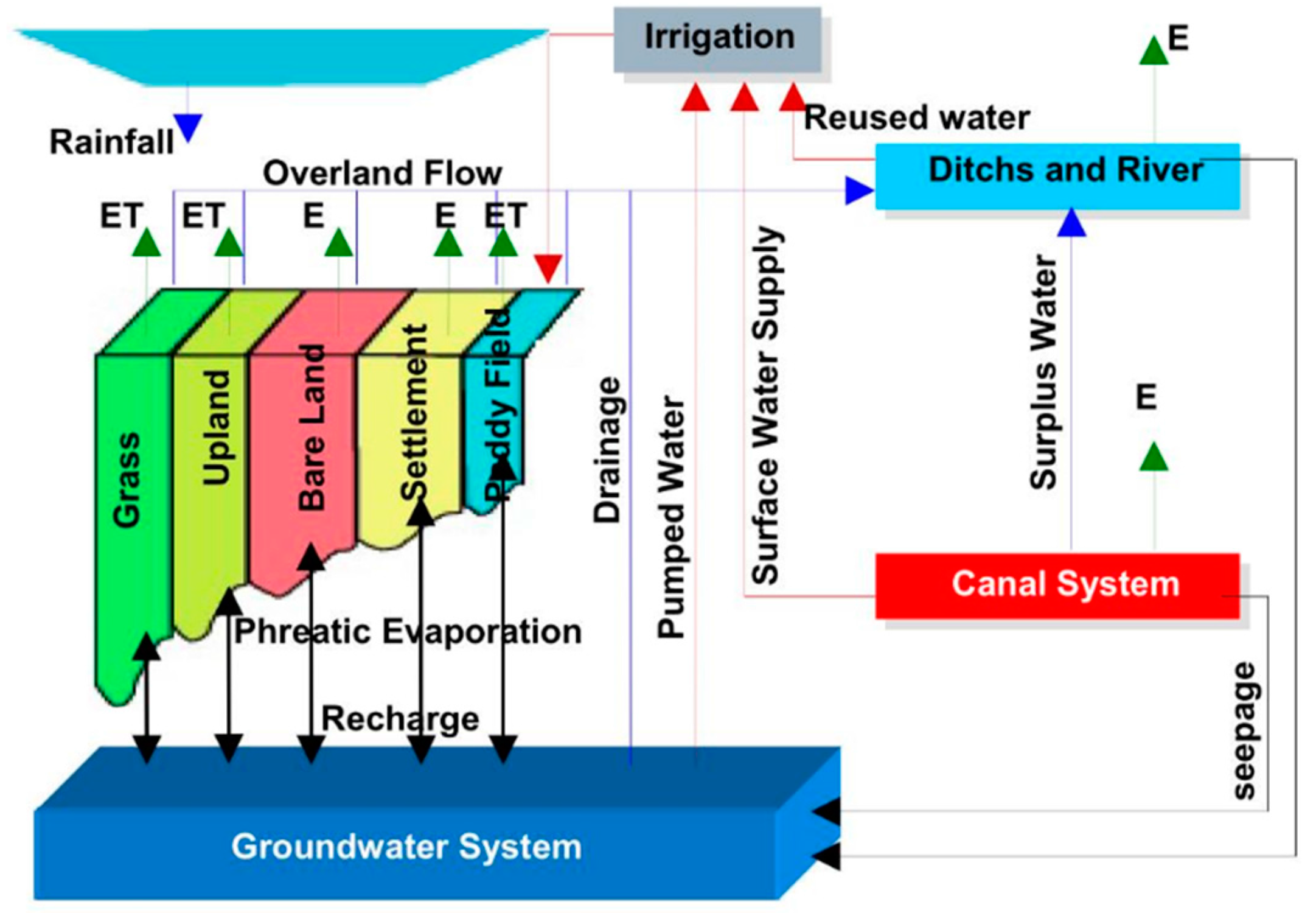
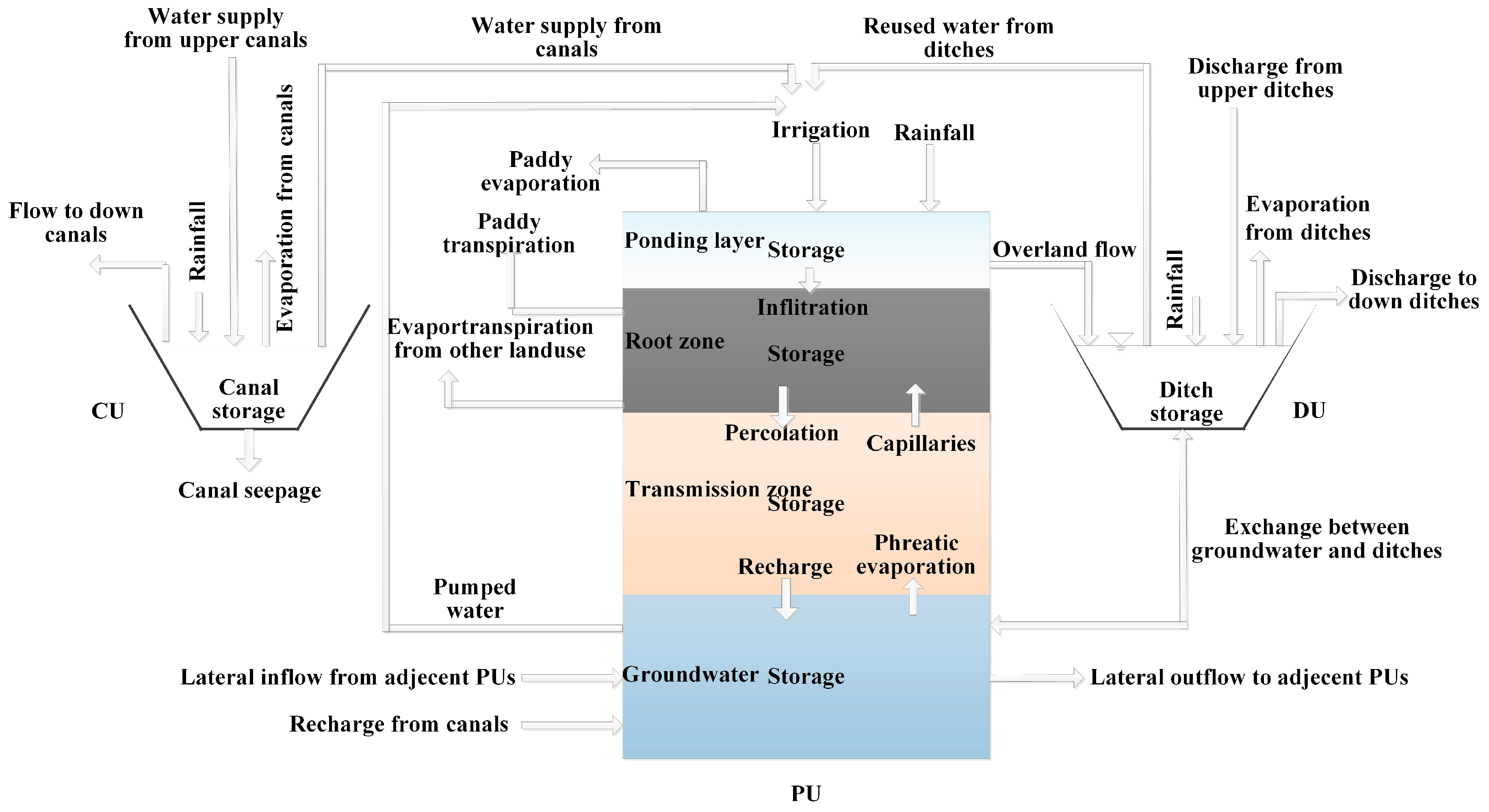


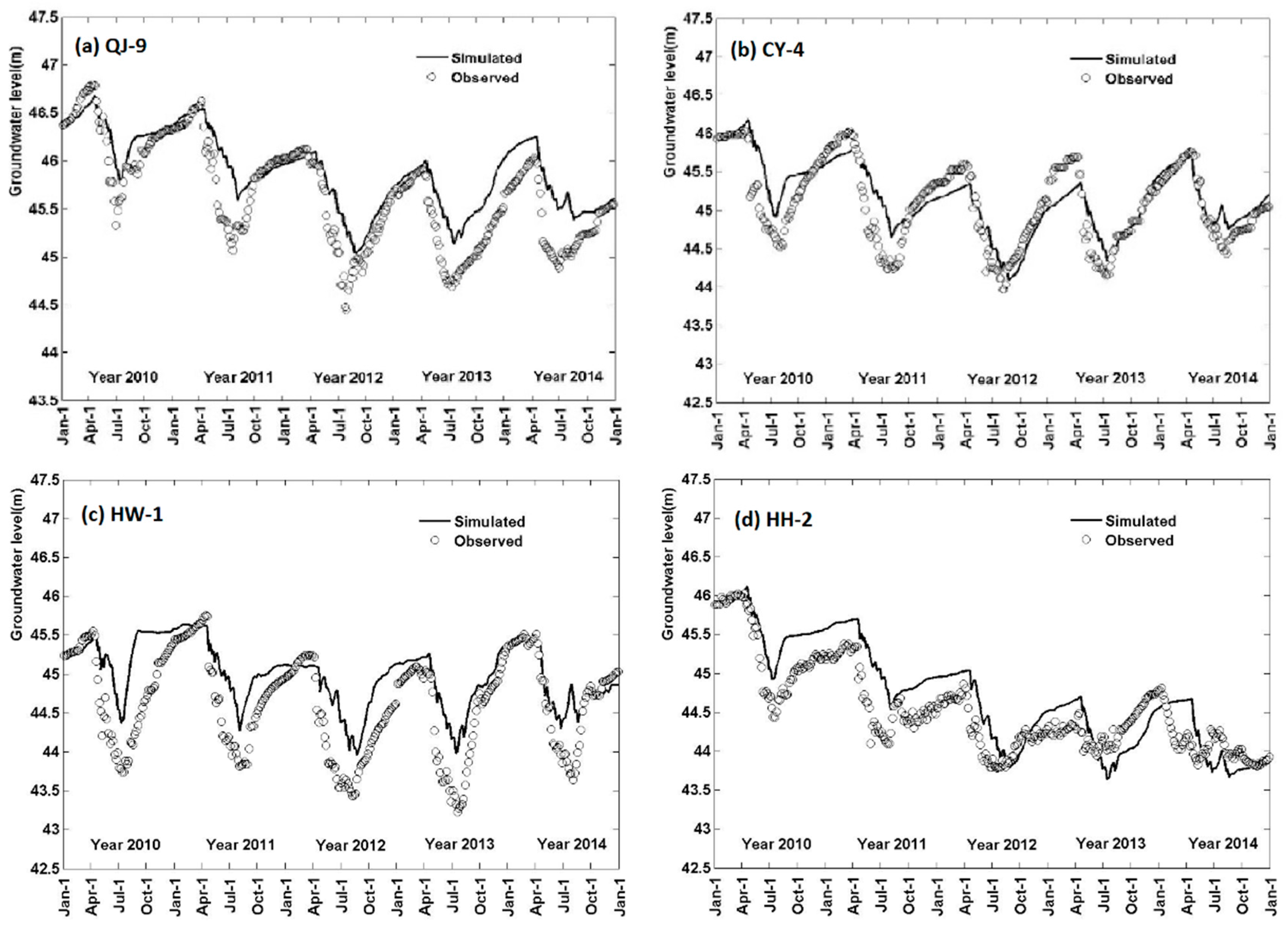
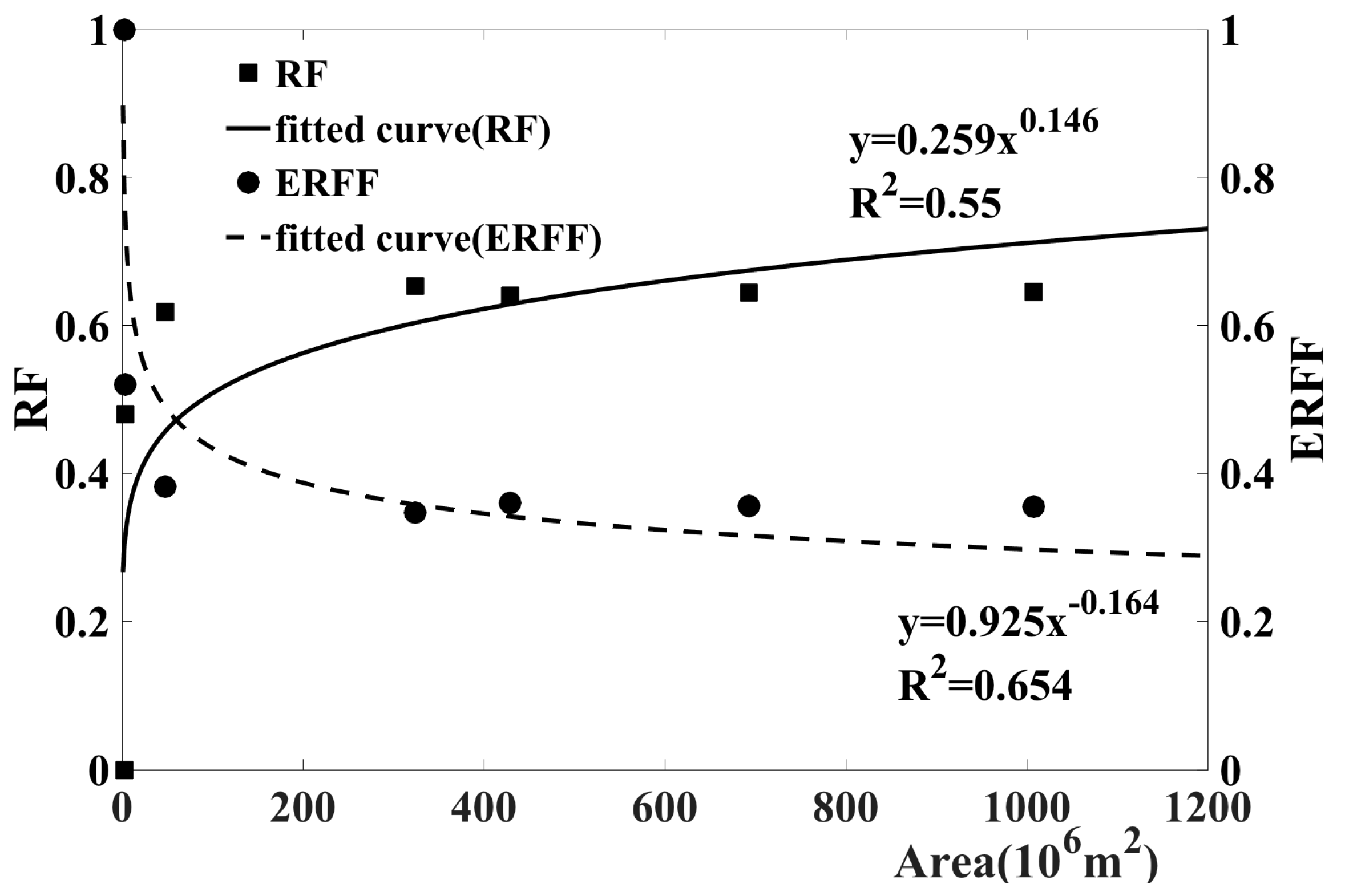

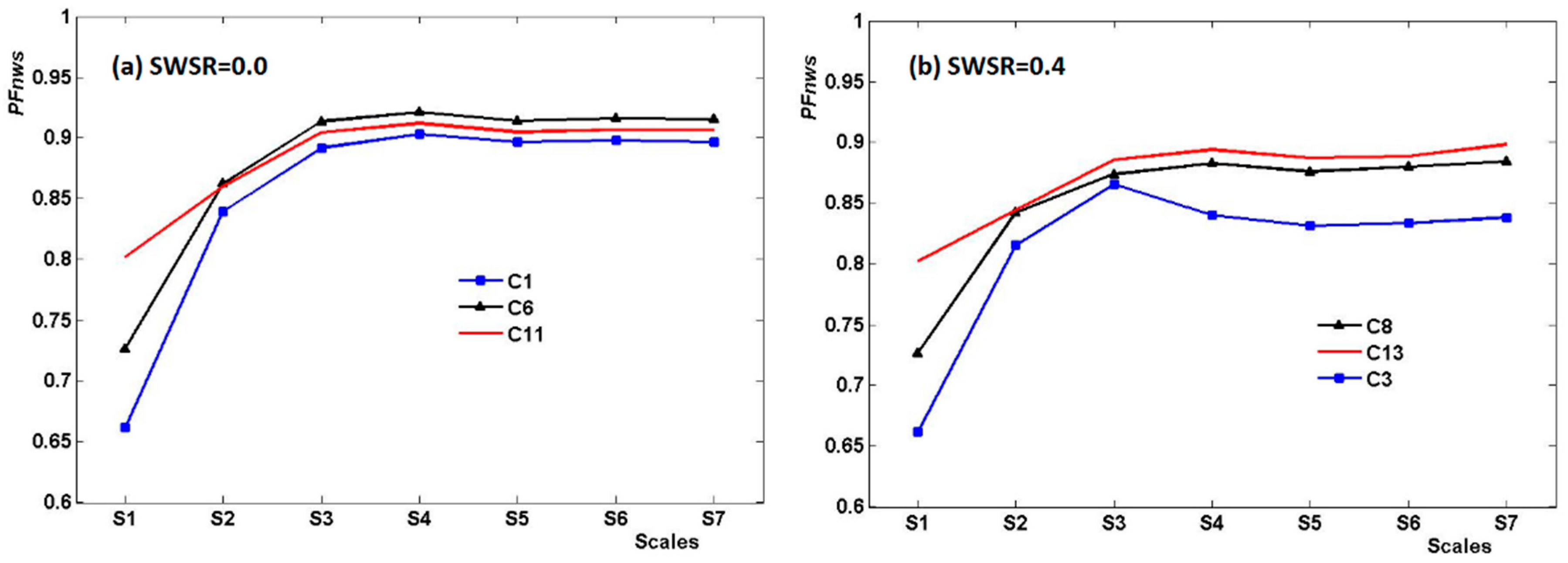
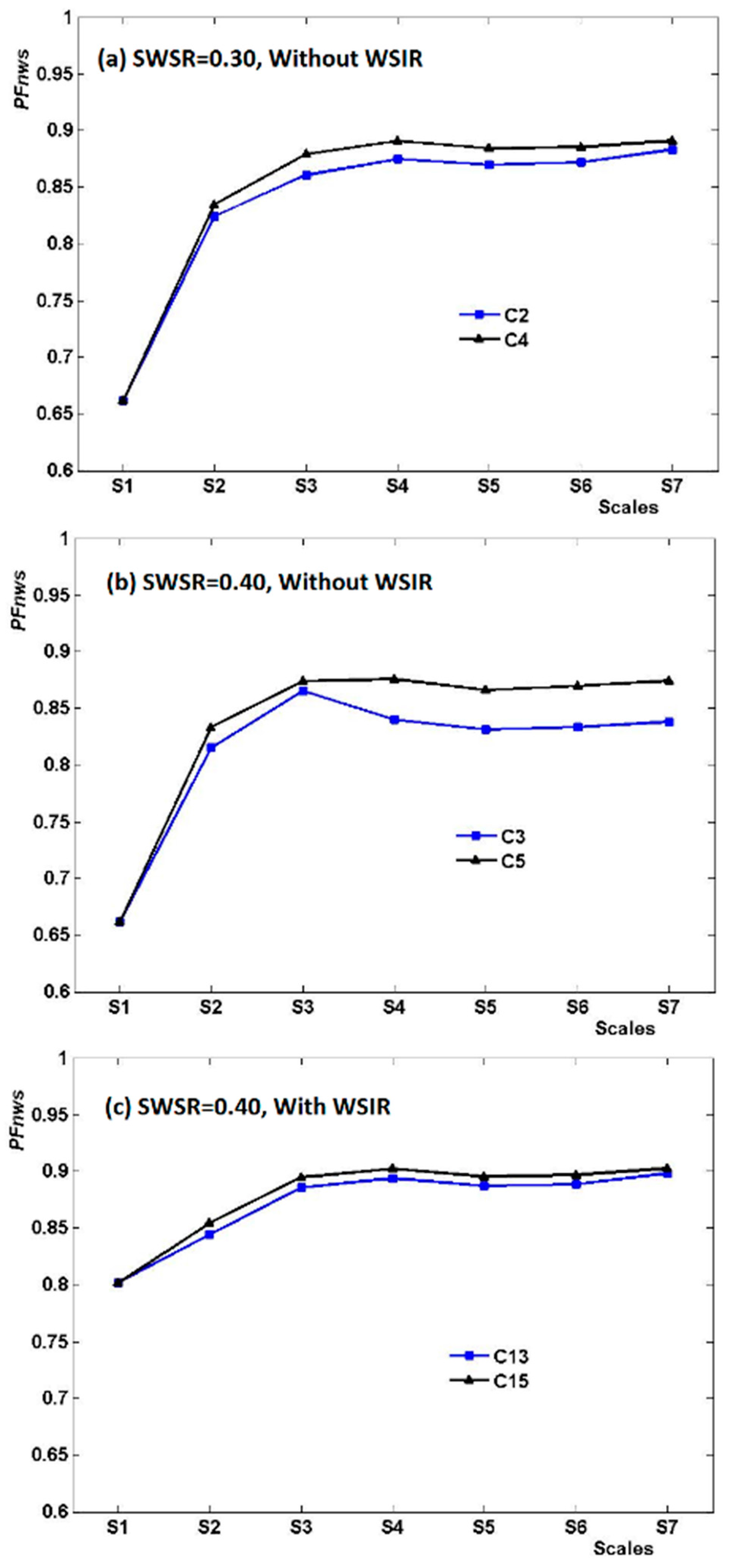
| Scale | Horizontal Range | Vertical Range | Items of Water Reuse |
|---|---|---|---|
| S1 (Field Scale) | Rice cultivated area in a PU (canals and ditches excluded) | Root zone | Without reused water |
| S2 | PU (canals and ditches included) | Unsaturated and saturated soil zone | Minimum of pumped water and groundwater recharge in the scale, reused water from ditches in the scale |
| S3 | A main-ditch command area (canals and ditches included) | Unsaturated and saturated soil zone | Minimum of pumped water and groundwater recharge in the scale, reused water from ditches in the scale |
| S4–S7 | Different numbers of main-ditch command areas (canals and ditches included) | Unsaturated and saturated soil zone | Minimum of pumped water and groundwater recharge in the scale, reused water from ditches in the scale |
| Scenarios | Irrigation Regime | Canal Water Delivery Coefficient | Surface Water Supply Ratio |
|---|---|---|---|
| C1 | Present | Presenta | Presentb |
| C2 | Present | Presenta | 0.30 |
| C3 | Present | Presenta | 0.40 |
| C4 | Present | Branch canal-0.80, main canal-0.70 | 0.30 |
| C5 | Present | Branch canal-0.80, main canal-0.70 | 0.40 |
| C6 | Low | Presenta | Presentb |
| C7 | Low | Presenta | 0.30 |
| C8 | Low | Presenta | 0.40 |
| C9 | Low | Branch canal-0.80, main canal-0.70 | 0.30 |
| C10 | Low | Branch canal-0.80, main canal-0.70 | 0.40 |
| C11 | High | Presenta | Presentb |
| C12 | High | Presenta | 0.30 |
| C13 | High | Presenta | 0.40 |
| C14 | High | Branch canal-0.80, main canal-0.70 | 0.30 |
| C15 | High | Branch canal-0.80, main canal-0.70 | 0.40 |
| Irrigation Regime | Ponding | Green | Early Tillering | Late Tillering | Jointing–Booting | Heading to Flowering | Milk Ripe | Yellow Ripe |
|---|---|---|---|---|---|---|---|---|
| Present (mm) | 20–55 | 30–65 | 30–65 | 30–65 | 30–65 | 30–65 | 30–65 | 0–30 |
| Low (mm) | 20–50 | 30–50 | 30–50 | 0–50 | 30–50 | 10–30 | 0–30 | 0–30 |
| High (mm) | 20–50 | 0.9θs–50 | 0.8θs–θs | 0.9θs–30 | 0.8θs–θs | 0.7θs–θs | ||
| Scales | S1 | S2 | S3 | S4 | S5 | S6 | S7 | |
|---|---|---|---|---|---|---|---|---|
| Precipitation/mm | 522.4 | 524.5 | 526.6 | 528.8 | 528.7 | 528.2 | 528.3 | |
| Irrigation/mm | Pumped from groundwater | 501.5 | 397.2 | 396.1 | 352.9 | 338.9 | 346.4 | 350.2 |
| Pumped from ditches | 2.1 | 1.6 | 2 | 1.5 | 1.6 | 1.7 | 1.6 | |
| Total irrigation | 503.5 | 398.8 | 398.1 | 354.4 | 340.4 | 348.1 | 351.8 | |
| ETrice/mm | 679 | 615.8 | 615.9 | 581.3 | 569.3 | 574.9 | 578.2 | |
| Water reused/mm | From groundwater from Within the scale | 0 | 190 | 232.1 | 238.1 | 232.5 | 234.4 | 231.5 |
| From ditches within the scale | 0 | 0.1 | 1.9 | 1.5 | 1.6 | 1.7 | 1.6 | |
| Total water reused | 0 | 190.1 | 234 | 239.7 | 234 | 236 | 233.1 | |
| Water use efficiency (PFnws) | 0.66 | 0.84 | 0.89 | 0.9 | 0.9 | 0.9 | 0.89 | |
© 2017 by the authors. Licensee MDPI, Basel, Switzerland. This article is an open access article distributed under the terms and conditions of the Creative Commons Attribution (CC BY) license (http://creativecommons.org/licenses/by/4.0/).
Share and Cite
Chen, H.; Gao, Z.; Zeng, W.; Liu, J.; Tan, X.; Han, S.; Wang, S.; Zhao, Y.; Yu, C. Scale Effects of Water Saving on Irrigation Efficiency: Case Study of a Rice-Based Groundwater Irrigation System on the Sanjiang Plain, Northeast China. Sustainability 2018, 10, 47. https://doi.org/10.3390/su10010047
Chen H, Gao Z, Zeng W, Liu J, Tan X, Han S, Wang S, Zhao Y, Yu C. Scale Effects of Water Saving on Irrigation Efficiency: Case Study of a Rice-Based Groundwater Irrigation System on the Sanjiang Plain, Northeast China. Sustainability. 2018; 10(1):47. https://doi.org/10.3390/su10010047
Chicago/Turabian StyleChen, Haorui, Zhanyi Gao, Wenzhi Zeng, Jing Liu, Xiao Tan, Songjun Han, Shaoli Wang, Yongqing Zhao, and Chengkun Yu. 2018. "Scale Effects of Water Saving on Irrigation Efficiency: Case Study of a Rice-Based Groundwater Irrigation System on the Sanjiang Plain, Northeast China" Sustainability 10, no. 1: 47. https://doi.org/10.3390/su10010047





